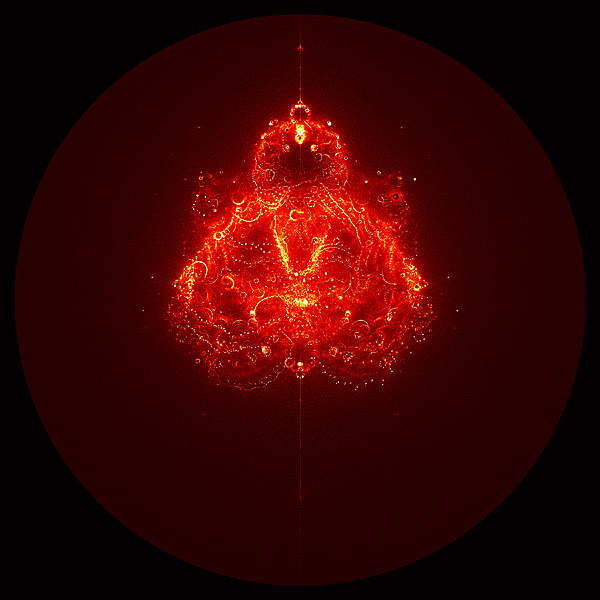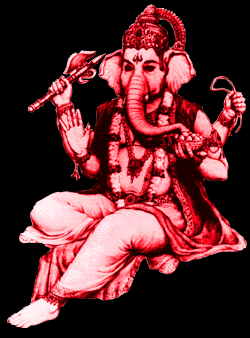Ganesha Fractal


The image on the front cover is a fractal: it is generated purely by a mathematical formula. The picture bears a striking resemblance to Shri Ganesha -- in fact if one looks closely, one can see a number of likenesses of Shri Ganesha's face, complete with ornaments and crown.
The overall shape also looks like a person sitting cross-legged, meditating. Some people may view this likeness as a pure coincidence, but if one considers that the formula which generates the image is relatively simple, and it was not "fiddled" to improve the image in any way, it seems like more than just a "coincidence".
Indeed the mathematician who first discovered the image remarked: "If I were a religious person I would certainly take this a some sort of sign".

Fractal Image Programmed & Rendered by Chris Dobbie based upon the work of Melinda Green. See original description below. See the original source page for this wonderful graphic: http://www.superliminal.com/fractals/bbrot/bbrot.htm
I don't know if anyone has tried this before, but I thought of a new way to look at the mandelbrot set. The process is simply this:
1) initialize the array of exit values to all zeros.
2) for each pixel: iterate the usual mandelbrot function:
for each iteration: find the pixel that the Z value lands on and increment the exit value for that pixel.
This method shows you which points in the complex plane are attractors for the m-set, or at least it shows you where the Z value spends it's time. I've posted the resulting picture to alt.binaries.pictures.fractals as "m-attr.gif". It's colored with the lowest values in red and proceeding through yellow, orange, green, blue and with the highest values as violet. I scaled the values into the color ramp using a simple form of histogram equalization that I developed for coloring mandelbrot images.
I find the resulting image fascinating. It is shaped somewhat like the m-set but the features do not really coincide with it. It consists of many spheroid-like shapes covered with distorted grid lines all wrapped in lace-like wispy features and other strange geometries.
I began to wonder what aspects of the m-set cause the various features. It then occurred to me that perhaps some of the features were being generated from points that originally start off in the m-set, and other by points from outside the m-set and that the image was just a composite of the two.
I then modified my program to generate those two images. I first created an image of the ordinary m-set which I then used as a reference array which the modified program used to iterate only those pixels that are, or are not in the m-set.
The picture generated from the pixels in the m-set looks somewhat like the first picture, but a bit simpler (as expected). It looks like a set of various sized spheroid shapes exploding outward from a cloud of red smoke. I posted this one as "bigbang.gif".
A totally unexpected thing happened when I generated the other picture (the one from the pixels that are *not* in the m-set). This one looks very much like some sort of seated Buddha. It looks just like one of those Indian paintings complete with eyes, ears, headdress, arms and crossed legs. It seems to be wearing lots of ornate jewelry and clothing. I'm not kidding. If I were a religious person I would certainly take this as some sort of sign. I posted this one under the name "ganesh.gif" because when I showed it to an Indian coworker of mine, he instantly recognized it as the god "Ganesh" which is the one with the head of an elephant.
The nice thing is that you don't need to take my word for it and retrieve my posted image because you should be able to generate the same picture from the above instructions. It's also interesting because it won't really be possible to zoom in much on the features because the picture is the result of the effects of all the points not in the m-set.
All three pictures were generated using a max-iteration value of 100,000. They are also very interesting and quite different when using lower values.
Click here to see Melinda Green's original fractal.
©Copyright Knowledge of Reality Magazine 1996-2005. All rights reserved.
Any comments, queries please email us. For Subscriptions click here.